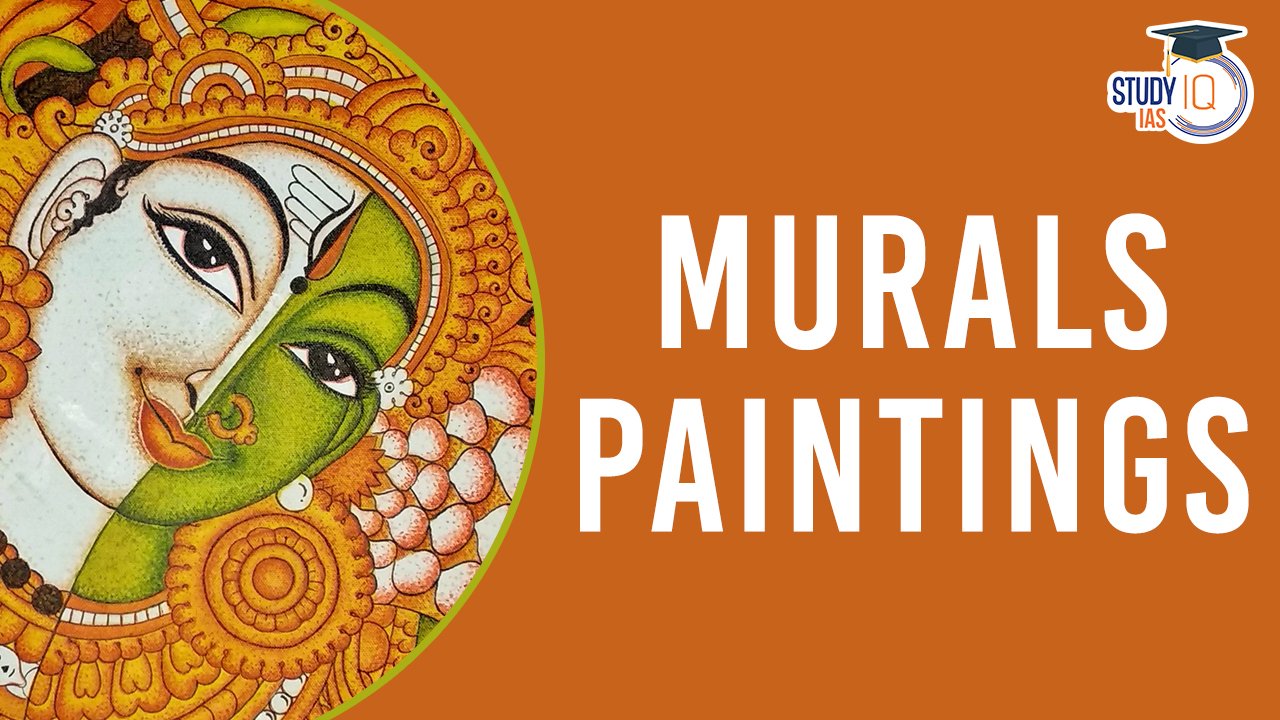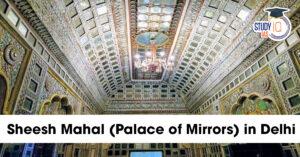Table of Contents
India boasts a diverse array of mural paintings, with notable examples spanning various regions and historical periods. The Ajanta Caves in Maharashtra showcase exquisite frescoes dating from the 2nd century BCE to the 6th century CE, depicting the life of Buddha.
Kerala’s vibrant mural tradition, found predominantly in temples, brings Hindu mythology to life with intricate detailing and vibrant colors. The Rajput and Mughal schools, known for miniature paintings, also incorporated murals in palaces, featuring royal courts and mythological tales. Lepakshi’s Vijayanagara-era Veerabhadra Temple and Tamil Nadu’s Sittanavasal Cave offer unique glimpses into ancient narratives. The Bhimbetka rock shelters in Madhya Pradesh house prehistoric paintings, while Mattancherry Palace in Kerala showcases a blend of Indian and European influences.
We’re now on WhatsApp. Click to Join
Historical Background of Mural Paintings in India
From the 2nd century BCE to the 8th-10th century CE, Indian mural painting boasts a rich and extensive history. These murals, showcasing diverse techniques, adorn over 20 locations across India, primarily in natural caves and rock-cut chambers. Different time periods gave rise to distinct mural painting styles, a variety that this page aims to highlight.
Discoveries of such paintings are widespread throughout the country, with notable locations including Ajanta, Armamalai Cave, Ravan Chhaya Rock Shelter, Bagh Caverns, Sittanavasal Caves, and the Kailasanatha Temple in Ellora. The elegance and beauty of these murals are evident in their presence within natural caves and rock-cut chambers.
Features of Mural Paintings
- Mural Paintings, due to their colossal size, are distinct from other graphic art forms.
- Their sheer enormity makes them unsuitable for paper, requiring large structures like caves and temples as their canvas.
- Hinduism, Buddhism, and Jainism are major thematic influences in Indian mural paintings.
- The murals’ organic relationship with architecture and broad public significance sets them apart.
- Expressive practicality characterizes Indian murals, with color, design, and theme-altering spatial perceptions.
- Mural Paintings are uniquely three-dimensional, actively transforming and sharing space.
- Ancient Indian mural pigments utilized natural resources like terracotta, chalk, red ochre, and yellow ochre mixed with animal fat.
- Subjects include human and animal figures, hunting scenes, family life, courtly affairs, and Buddhist ‘Jataka’ narratives.
- Executed by skilled ancient artists, these murals represent a fusion of meticulous craftsmanship and thematic depth.
Diverse Mural Traditions in India
India’s mural traditions span centuries, reflecting a rich tapestry of artistic diversity. From the ancient Ajanta caves’ Buddhist narratives to Ellora’s synthesis of Hindu, Jain, and Buddhist themes, each region adds unique hues to the canvas. Sittanavasal in Tamil Nadu echoes Ajanta’s elegance, while Bagh in Madhya Pradesh offers secular reflections. Armamalai depicts Jain tales, and Ravan Chhaya in Odisha portrays royal processions. Lepakshi in Andhra Pradesh delves into religious epics, while Jogimara in Chhattisgarh tells ancient love stories. From Badami’s Chalukyan legacy to Nayaka murals, each tradition contributes to India’s intricate mosaic of cultural expressions.
Ajanta Cave Paintings
- Dating back to the 4th century AD, Ajanta caves, carved from volcanic rocks, comprise 29 horseshoe-shaped caves.
- The murals within took four to five centuries to complete, showcasing a transition from the Sunga to the Gupta period.
- Caves 1 and 2 feature the most recent paintings, depicting human ideals, societal fabric, and detailed period styles.
- Murals illustrate diverse themes from Jataka stories to Buddha’s life, using tempera style and a rich palette of organic colours.
Ellora Cave Paintings
- Ellora’s five caves, notably the Kailasa temple, display murals created in two phases over millennia.
- The first phase occurred during cave carving, featuring older artwork with Vishnu, Lakshmi, and Shaiva holy men.
- Later paintings depict a procession of Shaiva holy men in Gujarati style, representing Buddhism, Jainism, and Hinduism.
- Images of Goddess Lakshmi and Lord Vishnu are prominent in Ellora’s cave paintings.
Sittanavasal Cave
- Resembling Ajanta and Bagh paintings, Sittanavasal Cave’s murals date from either the Pallava or 7th century Pandya period.
- Jain Samavasarana’s subject inspires the paintings, showcasing monks collecting flowers in a pond with lotuses.
- The scene depicts Samavasarana, a significant Jain religious event, featuring animals, celestial beings, and gods in an audience hall.
Bagh Cave Paintings
- An extension of the Ajanta school, Bagh caves in Madhya Pradesh exhibit murals comparable in design, execution, and ornamentation.
- Neatly modeled figures illustrate Buddhist and Jataka tales, reflecting religious topics intertwined with daily life.
- Despite current sparse and deteriorated conditions, Bagh cave paintings present a secular perspective.
Armamalai Cave Paintings
- Natural caves in Tamil Nadu, converted into an 8th-century Jain temple, feature vibrant murals depicting Astathik Palakas and Jainism.
- The colorful narratives showcase deities defending eight corners, contributing to the artistic richness of Armamalai Cave.
Ravan Chhaya Rock Shelter
- Situated in Odisha, Ravan Chhaya Rock Shelter’s frescoes on a half-opened umbrella-shaped rock depict a royal procession from the 7th century.
- Representing both Chola and later paintings from the 11th century, these ancient artworks offer glimpses into royal and religious life.
Lepakshi Paintings
- Dating to the 16th century in Andhra Pradesh, Lepakshi’s mural paintings on the Veerabhadra temple walls focus on religious themes from the Ramayana, Mahabharata, and Vishnu’s incarnations.
- These paintings, from the Vijayanagara period, show a shift in quality, utilizing black outlines and a unique absence of primary colors.
Jogimara Cave Paintings
- An artificially created cave in Chhattisgarh, Jogimara Cave, dating from 1000-300 BC, contains paintings and inscriptions in Brahmi script.
- Depicting a love story and adorned with dancing couples, elephants, and fish, Jogimara Cave offers insights into ancient artistic expressions.
Badami Murals
- Located in the capital of the western Chalukyan dynasty, Badami caves’ murals showcase scenes of palace life, featuring King Kirtivarman and Queen.
- Representing a later mural tradition, these paintings continue the artistic legacy from Ajanta to Badami, showcasing Chalukya’s artistic techniques.
Pallavas, Pandyas, and Cholas Murals
- Tamil Nadu’s Pallavas, Pandyas, and Cholas successively patronized murals, depicting stories from Mahavira’s life, celestial nymphs, and Lord Shiva’s manifestations.
- The Cholas, during their dominance from the 9th to the 13th century, left significant murals at Brihadeswara Temple, emphasizing Lord Shiva’s narratives.
Vijayanagara Murals
- After the Chola era, the Vijayanagara Dynasty ruled, leaving murals at Thiruparankundram with depictions from dynastic history, Mahabharata, and Ramayana.
- Vijayanagara paintings exhibit a flexible yet still quality, portraying people, events, and objects with unique characteristics.
Naayaka Murals
- Extending the Vijayanagara style, Nayaka murals at places like Thiruparankundram and Tiruvarur illustrate episodes from the Mahabharata, Ramayana, and Krishna Leela.
- Displaying slender waists and expressive faces, Nayaka paintings showcase a distinct evolution in the depiction of figures and emotions.
Kerala Murals
- Integrating Nayaka and Vijayanagara styles, Kerala murals draw inspiration from Kathakali and Kalam Ezhuthu traditions.
- These three-dimensional paintings on shrines, temples, and palace walls narrate Hindu mythology, localized interpretations of epics, and oral tales.
Mural Paintings UPSC
India’s diverse mural traditions unfold across centuries, capturing historical, religious, and cultural nuances. The ancient Ajanta Caves in Maharashtra, dating from the 2nd century BCE to the 6th century CE, portray Buddha’s life. Kerala’s vibrant temple murals breathe life into Hindu mythology, while the Rajput and Mughal schools incorporate murals in palaces. From Ellora’s synthesis of Hindu, Jain, and Buddhist themes to Sittanavasal’s Jain-inspired elegance, each region contributes unique hues. Bagh reflects secular life, Armamalai depicts Jain narratives, and Ravan Chhaya in Odisha portrays royal processions. These diverse traditions showcase India’s intricate mosaic of cultural expressions, echoing stories from prehistoric times to the Vijayanagara and Nayaka periods.


 Chakma and Hajong Communities: History, ...
Chakma and Hajong Communities: History, ...
 Sheesh Mahal in Delhi Restoration, Archi...
Sheesh Mahal in Delhi Restoration, Archi...
 Bonalu Festival 2025: Date, History, Rit...
Bonalu Festival 2025: Date, History, Rit...





















